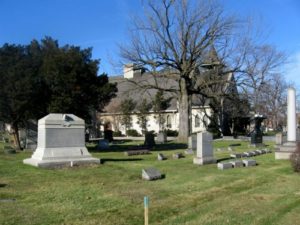By Elizabeth Britt, Class of 2013

Oak Woods Cemetery on the south side has a long history in Chicago and is also the final resting place of many influential African-Americans. This beautiful pastoral setting is a welcome respite from the bustling city and exactly what the planners thought when they chose the location. Originally in the loop, the cemetery moved to 67th and Greenwood after the fire, bringing along the relic of what remained from the fire. The fused nails seen among the charred remains give testimony to the fire’s intensity.
The location along the train line also allowed easy access. Upon death, your loved ones could rent an entire funeral train for $25 or just a private coach for $5. Families would then visit and picnic in cemeteries, much like we use parks today. Proximity to the lake made for nice breezes amidst the Adolph Strauck-designed landscape. He is famous for Cincinnati’s Spring Hill Cemetery.
Although the final home of the first Secret Service agent to die in the line of duty, the vacuum cleaner Hoover family, the always colorful Big Bill Thompson, and mob boss Big Jim Colosimo, the focus of this tour is Civil War to Civil Rights. Prominent characters in the evolution of civil rights such as Ida B. Wells, Bishop Henry Ford, Jesse Owens and Harold Washington lend their voices and efforts to the cause by example and/or action. Oak Woods is also the home of many veterans of the Tuskegee Air Men. We explore the roles of these courageous individuals and significant events in Illinois in pursuit of equality and better living, as well as Chicago’s pivotal role in the Great Migration of millions of African-Americans moving north.
John Johnson was one of these influential African Americans. He was born in Arkansas City, Arkansas and his love of learning made him repeat eighth grade because there was no black high school in his hometown. He moved to Chicago and attended DuSable High School, graduating with Redd Foxx and Nat King Cole. He went on to the University of Chicago and worked at a life insurance company while attending classes. He also started compiling news clippings, which gave him the idea of publishing. After graduation, he launched Negro Digest, which became Black World. Three years later he published Ebony and in 1951, Jet magazine. They were enormously successful and you still see those names along a Michigan Avenue building. In 1955, Jet magazine made the bold move of publishing pictures of Emmett Till in his coffin showing the world the brutality of racism. The murder of Emmett Till, and informing the world of it, galvanized African Americans to fight for civil rights. A few months later, Rosa Parks would make her stand as well.
The Civil War to Civil Rights tour begins at the large, beautiful and controversial monument to the 4,000 Confederate soldiers buried in a mass grave. These soldiers had been POW’s in Camp Douglas and died along with 12 Union guards. Camp Douglas sat where the Lake Meadows residential complex is now at 31st Street. Most of these prisoners came from the Battle of Ft. Donelson, Tennessee in 1862. The camp was first a Union soldier training ground and then converted to a POW camp. It held 12,000 men at its peak in a space that was meant for 8,000. Conditions, as in all camps, were horrid and death was likely to harsh conditions and diseases that were rampant throughout the camp.

The soldiers were originally interned in Lincoln Park and then moved when Lincoln Park relocated their graves. But who would have them? Rosehill Cemetery refused them and thus, they came to Oak Woods. There was quite a backlash to this decision, and in response, a Cenotaph was erected commemorating the Union soldiers at the site as well.
The land on which they are buried is actually Federal land. Graves are in concentric circles around the monument and the names of all 4000 are listed on the monument, dedicated in 1895. It is the largest mass grave in the Western Hemisphere. Reviewing the names illuminates the tragedy of losing multiple family members at the same time. The only actual headstones are 12 for the Union guards, which are curved on top, representing the Union and one lone Confederate headstone erected by a family member later on with the angled top, representing the Confederate break with the Union.

In addition, there are Union soldiers from Post 91 buried with a statue of Lincoln at the site. These are located as far away from the Confederate graves as possible. Near them are graves from the Old Soldiers Home-which used to be the hospital at Camp Douglas and is now St. Joseph Carondelet Home. Senator Lyman Trumball, Lincoln’s friend and ally in Congress, is buried nearby as well. He was instrumental in pushing forth the 13th Amendment, the Emancipation Proclamation. After Lincoln’s death, he tried to see his vision of reconciliation and union realized, but was thwarted by President Johnson’s more punitive actions.
There are many more stories, beautiful monuments and fascinating people to discover. Come join us! The tour is offered in summer and meets one Saturday each month from 10-11:45am. More docents are needed and if you are interested, please contact Mary Jo Hoag or Ellen Shubart.





Thanks, Liz, for a lovely description of Oak Woods. We would love to see more docents and tourists on our tours.
Docents should hold off from visiting for a bit, however, as the place has been flooded due to the recent rains and some piping problems in the cemetery itself. The next our is in June but please check before you head out as we’ll know more about if the cemetery is open.
Elizabeth, what a fascinating history you tell here; you’ve certainly whetted my appetite to take this tour ! I look forward to coming when the ground dries.